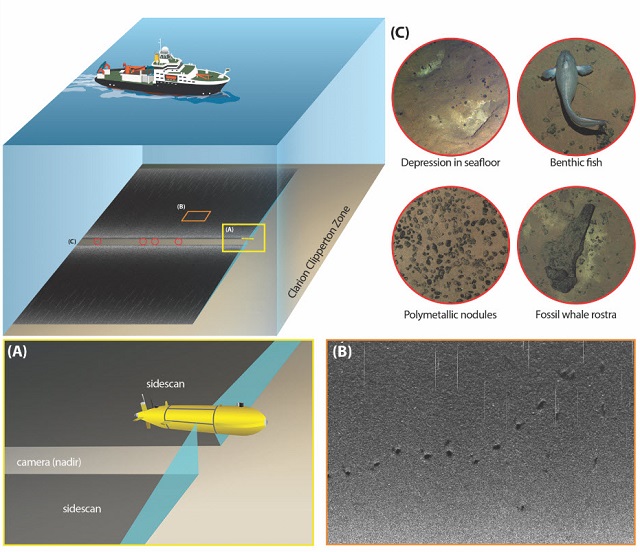"Whale Tracks" Found in Areas Targeted for Deep-Sea Mining
A series of depressions forming mysterious “tracks” on the seafloor may be an unprecedented record of deep-diving whales, according to scientists from the National Oceanography Centre (NOC) and the University of Southampton.
The observations were made in a region of the Pacific Ocean targeted for deep-sea nodule mining. In 2015, the RRS James Cook visited the Clarion Clipperton Zone to characterize the habitats and species there. The expedition used the Autosub6000 AUV along with a suite of other data collection methods to form an environmental baseline for this area.
When processing the side-scan sonar data, the research team noticed a series of depressions on the seafloor. The tracks were not related to mining or scientific operations within the area, they appeared too large to be created by fish or any other typical deep-sea animals and they were not thought to be formed by geological processes, such as gas or fluid seepage. However, they did resemble those observed in other regions of the world’s oceans attributed to whales.
Commenting on the discovery, lead author of the study Dr. Leigh Marsh, said: “Further analysis revealed that the depressions were not randomly distributed, or occurring in isolation, but formed curvilinear features, or “tracks,” that almost looked like footprints.”
Over 3539 individual depressions were detected (in an area roughly the size of central London), to a maximum water depth of 4,258 meters (just over 2.5 miles). If the tracks are made by a whale, they would extend the known maximum dive depth of a marine mammal by over 1,000 meters.
Deep-diving whales – such as beaked whales or sperm whales – are the most specialized and least understood of all marine mammals. They are inconspicuous and elusive, surfacing only briefly to breathe. Much of what is known about these whales has been learned from stranded specimens or material from museum collections, and as such, there is very little knowledge regarding their behavior, habitat preferences or diets.
Beaked whales have been reported to make similar markings on deep-sea mud volcanoes and, historically, there are reports of sperm whales ploughing the deep seafloor and getting entangled in telecommunication cables. In shallower waters, on the continental shelf, other species of whale are known to use the seafloor for feeding or removing dead skin, however, in the deep ocean, it is still unclear why whales would make such marks.
Marsh said: “Like many discoveries in ocean exploration, these findings were totally unplanned and resulted from novel application of new technology. The next step would be to provide more conclusive evidence that whales are makings these tracks. In the future, we hope to be able to use an ROV to sample the sediments in the tracks and use eDNA techniques to see whether or not any whale skin cells are present. However, electronic depth-tags, attached to the animals themselves, will provide direct evidence that whales can dive to these abyssal depths.”
The research was published in Royal Society Open Science and was funded by the European Union Seventh Framework Programme under the MIDAS (Managing Impacts of Deep-seA reSource exploitation) project. Funding was also provided from the UK Natural Environment Research Council.

Image provided from the oblique camera from Autosub6000 Mission 79 (M79) within the APEI shows two depressions, inferred to be those also observed from acoustic data. White dashed line indicates an area where sediment from the excavation has subsequently covered nodules within the vicinity. Eroded edges would suggest that these particular depressions have not been made in recent years. Depth: 4,153 m. Credit: Marsh et al., 2018.
